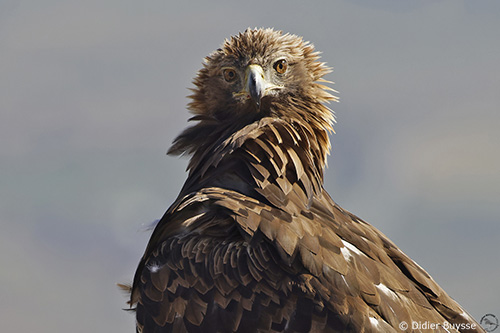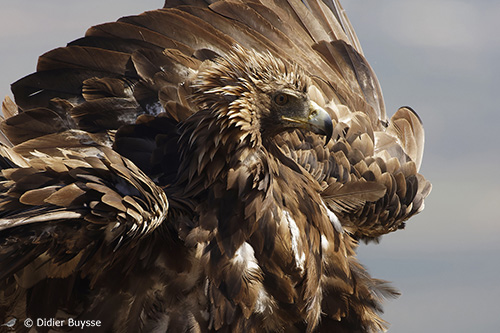
Photographer:
Didier Buysse
Vision d’Oiseaux
All pictures on this page are owned by Didier Buysse.
These images and the text are subject to copyright and cannot be used without express authorization from the owners. Legal issues
Text by Nicole Bouglouan
Sources:
Golden Eagle Symbolism: Soaring Insights into One of Nature’s Majestic Creatures
Wikipedia, the free encyclopaedia
His Majesty the Golden Eagle
The sun had been shining for about an hour, but the rocks were still soaked with the cold of the night and the surrounding vegetation shone with thousands of pearls of dew. A light but tenacious breeze enveloped the landscape with its icy breath.
The mountain… Its steep landscapes, the rocky cliffs and their welcoming ledges, the valleys bordered by wooded slopes where the rock appeared between each bush, noisy waterfalls surrounded by white mist carried by the wind where the sun amused itself by drawing a rainbow. This calm and spectacular Nature contrasted with a magnificent blue sky that highlighted this captivating setting.

It is in this particular environment that His Majesty the Golden Eagle evolves.
The Golden Eagle (Aquila chrysaetos) is the largest French bird of prey with a wingspan of over two metres. Very agile and fast, equipped with powerful talons and a hooked, robust and sharp beak, it is a fearsome and audacious predator, capable of choosing prey of all sizes. Its proud gaze, highlighted by a prominent eyebrow arch, is impressive. Its visual acuity is extraordinary, estimated at eight times greater than that of humans. An average-sized prey can be detected more than a kilometre away!
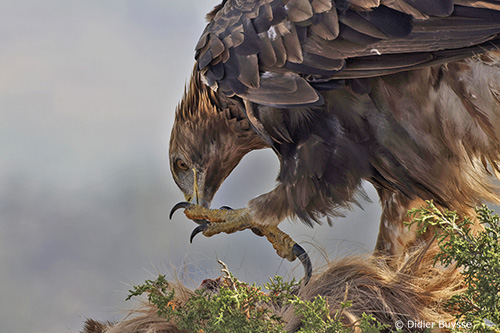
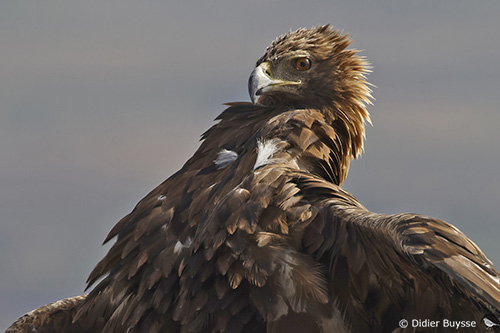
It mainly hunts mammals such as hares, squirrels, foxes and marmots, but also larger prey such as young mountain mammals, goats, ibex and deer. It also consumes birds, especially quails, partridges and pigeons, although larger species such as swans, cranes and crows are also potential prey. Everything depends on the availability of food resources according to the seasons or the habitat. During the winter, when its preferred prey are scarcer, it becomes a scavenger and feeds on animal carcasses. But it can also be opportunistic, and any animal of suitable size that it encounters may be hunted.
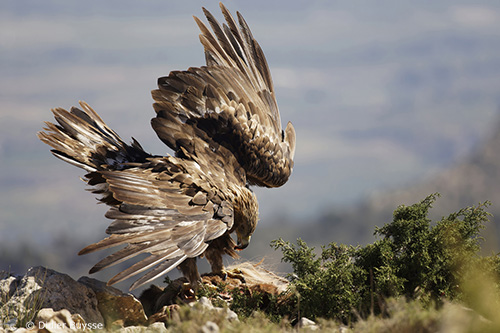
Its flight is powerful with ample wingbeats alternating with glides. While gliding in circles, the wings are slightly raised or almost horizontal. In direct gliding, the arm is raised but the hand remains horizontal. Its speed in flight can reach 45-50 km/h and up to 130 km/h. In a dive, this large raptor can reach around 320 km/h.
These eagles often hunt in pairs, flying high in the sky in search of prey. The hunting technique is simple: when the victim is spotted, the eagle swoops down and captures it by surprise, legs stretched out forward and claws open to grab the prey and carry it away. The sharp beak is used to tear flesh.
But it also happens to hunt on the ground where the eagle can then be observed running while flapping its wings continuously.
Eagles that hunt in pairs at breeding time have a very well-developed technique, with one member of the pair distracting the prey while the other captures and kills it.
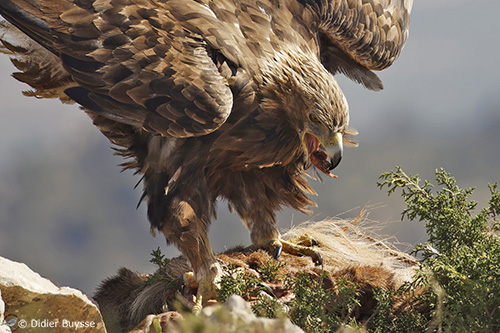
Perched on a rocky ridge, the eagle is occupied by its prey with long red and white fur, perhaps a fox? Standing above the carcass, it opens its wings and shakes its plumage while looking for the best place to plunge its sharp beak. It removes the flesh, one piece after the other, taking its time…
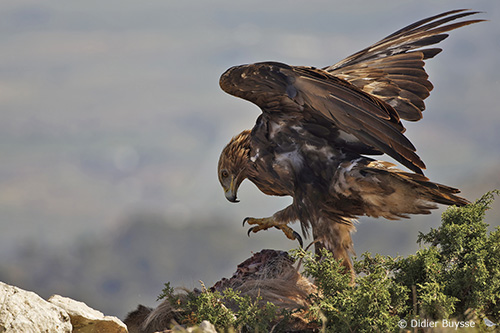
A group of vultures already there before the eagle's arrival observes the scene attentively. But the eagle is watching them and keeping them at a distance in case they are attracted by the prey. Its impressive stature and proud look should discourage more than one! Everything seems calm. It shakes its feathers again and ruffles them, thus appearing more imposing. Soothed, it resumes its meal where it had left off.
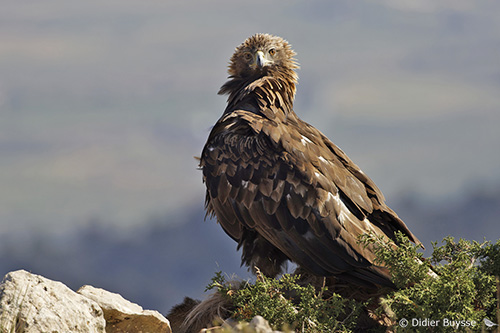
Even at this moment, the Golden Eagle remains elegant and majestic in front of this mountainous setting bathed in sunlight, its legs in the greenery, its penetrating gaze fixed on the lens... What a magnificent moment that allows us to observe it up close and admire it, without thinking of anything other than the beauty of Nature.
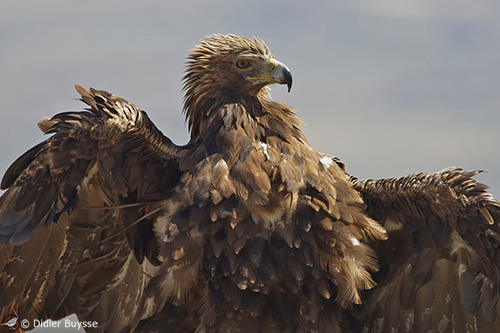
The Golden Eagle is one of the best-known raptors in the Northern Hemisphere and the most widespread eagle species.
It is found throughout North America and northern Eurasia, and is scattered in North Africa.
It is found primarily in mountains at altitudes ranging from 2,000 to 5,500 metres.
But the Golden Eagle frequents a wide variety of habitats. It is found from sea level to the highest mountains, and at all intermediate elevations. Often seen in open grassland, desert, alpine, or shrub-steppe habitats depending on the distribution, it is also found in many types of forest landscapes.
It frequents rocky areas with open spaces that facilitate hunting. It is sedentary and territorial. It defends its territory, as feeding and hunting areas are occupied all year round.

The species is monogamous and the pair bonds can last a lifetime until one of them dies.
The displays take place in winter and are spectacular as with most raptors. The nest or eyrie is often on a rocky ledge at the top of a cliff, but also in a tree, on a building or other human constructions. The nesting site requires quiet places with rock walls or large trees, and high points on the rocks or trees to land and leave. The same nest or one of the nests is used year after year. Each pair usually has several nests, 3 or 4, sometimes more, up to 10 or 12. It is an enormous structure, up to 2 metres or more wide and deep, because the adults add material each year.
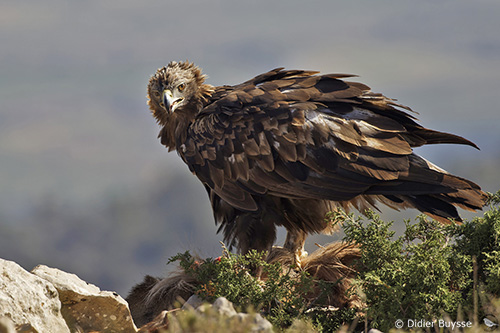
The female usually lays two eggs three days apart. The incubation lasts 41 to 45 days, mainly by the female, although the male participates in incubation for more or less long periods. The chicks hatch three days apart and are covered in white down. The youngest often dies victim of repeated attacks by the older one. The remaining young is fed by both parents, and two to three months later, it leaves the nest but will still depend on adults for food for a few months.
Despite some problems caused by human presence, the Golden Eagle is not currently globally threatened.
Lead poisoning from eating carcasses of pests, collisions with vehicles or wind turbines and electrocutions on utility poles are usual problems. Added to this is urbanization and agricultural expansion, which are changing habitats, feeding areas, and nesting sites.
The Golden Eagle is currently evaluated as Least Concern.
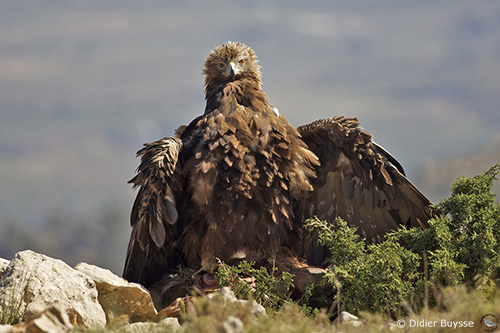
The Golden Eagle is a symbol of strength, foresight and freedom.
It is also associated with courage, leadership and spiritual protection.
Its ease in soaring high in the sky symbolizes freedom and independence.
It is often considered a spiritual guide. Its keen perception brings wisdom and guidance and helps one to continue on one's path with confidence.
The Golden Eagle symbolizes all these aspects in different cultures, including Native American traditions, Norse mythology and ancient Greek beliefs.
The symbolism of this magnificent eagle makes this raptor a living myth present in Nature. Man can observe and study it, or simply admire it.
